The top causes of holes in indoor plants leaves are a lack of water, lack of nutrients and a lack of light. As the leaf gets weaker, tearing can occur which will cause holes. Insects can get to your indoor plants if they are transferred by other plants or on the wind via a window.
This article will explore why indoor plants can develop holes in their leaves plus easy ways to solve each one naturally. This starts by identifying the problem and treating the pest or giving the plant the environment it needs.
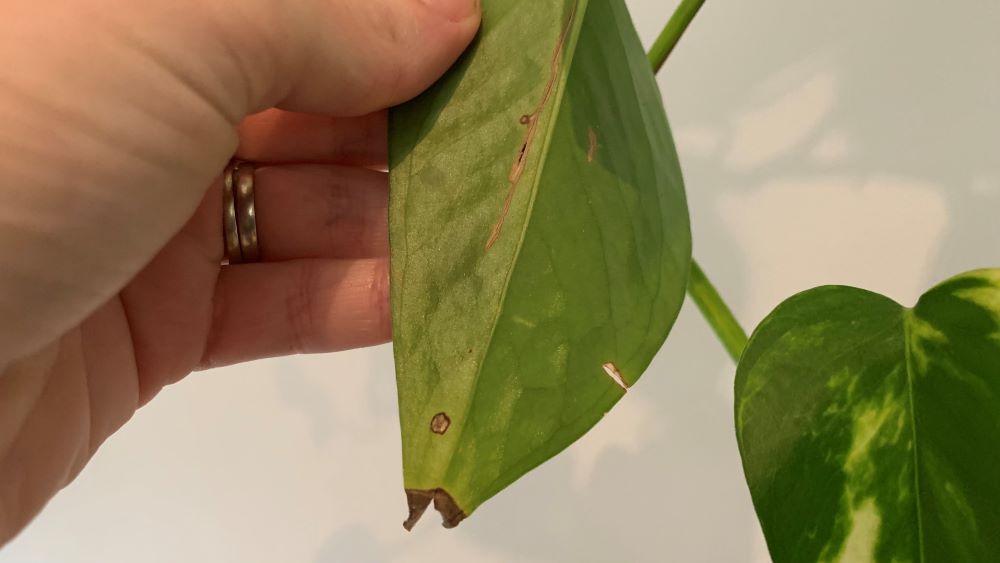
Top causes of holes in indoor plant leaves and solutions
Here are the top causes of holes in indoor plant leaves and how to solve each one.
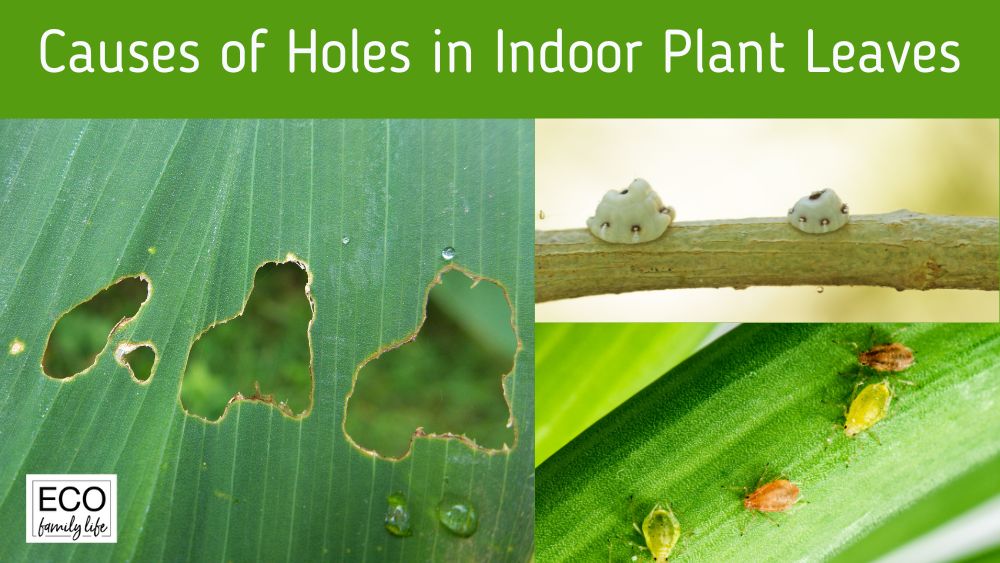
1. Your indoor plant is too dry
Indoor plants that are allowed to dry out too much can develop holes in their leaves. Even drought hardy plants like sansevieria (Snake plant) and ZZ plant can dry out too much causing leaf damage.
Plants that are not getting enough water will develop holes in their leaves as their leaves lose the natural strength. Some plants like bird of paradise will naturally tear in lines towards the stem of the plant.
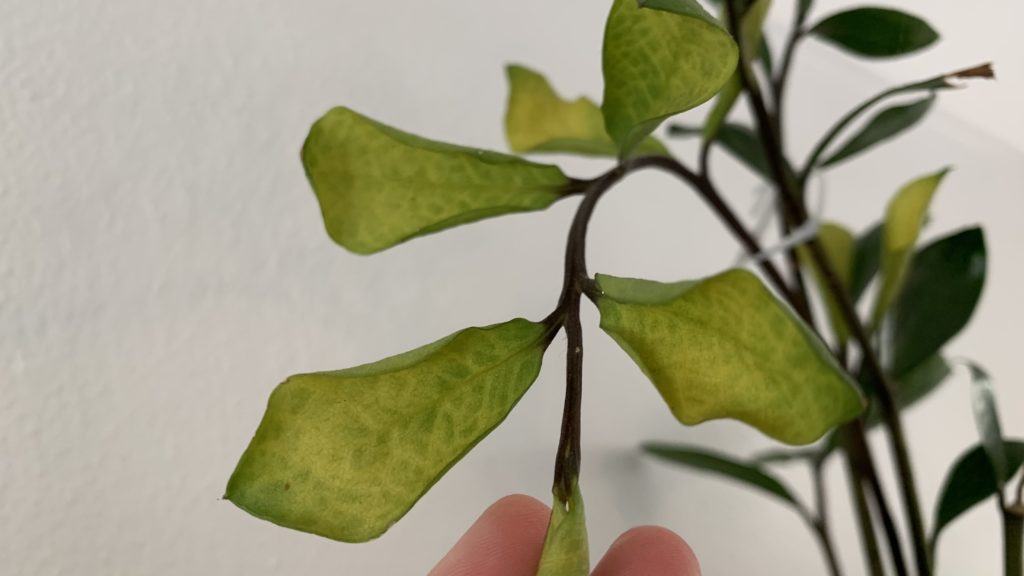
Pothos will often develop curled leaves that will develop brown spots and marks. These can open up to holes which will continue to grow larger.
Each indoor plant will have a different need for water and this will also vary depending on the time of year. I find that pothos need water every week during the warmer months and if you are heating your home over winter. If they don’t get enough water the leaves will droop, turn yellow and then brown.
Zanzibar gem or ZZ plants are on the other extreme and prefer a deep water once per month. I like to take the whole pot over to my sink and soak the whole root area. Allow the pot to drain well before returning it to its pot tray.
The best way to know if your indoor plant needs water is to test it with your finger or a popsicle stick. Pop your finger or stick into the soil and if it feels dry or the stick comes out clean then it is time to water your plant.
I find that monstera are somewhere between the water needs of sansevieria and pothos. Monstera are drought hardy and I like to water them every 1-2 weeks. Slow down your watering for all of your indoor plants over winter. When the weather is cooler it will take longer for the soil to dry out. Their growth will slow and their roots can develop fungal root rot.
2. Your indoor plant is not getting enough fertilizer
Indoor plants are completely reliant on you for their nutrients. If they are not getting enough then they can develop tears and holes in their leaves. Nutrients deficiencies such as nitrogen and iron will appear as yellowing on the leaves first. Eventually this yellow will turn to brown and holes can appear.
To make sure your indoor plant is getting the nutrients it needs start by planting it in good quality potting soil. For most indoor plants a general, all-purpose potting soil works well. Look out for one with a slow release fertilizer to feed your plant for the first 6 months.
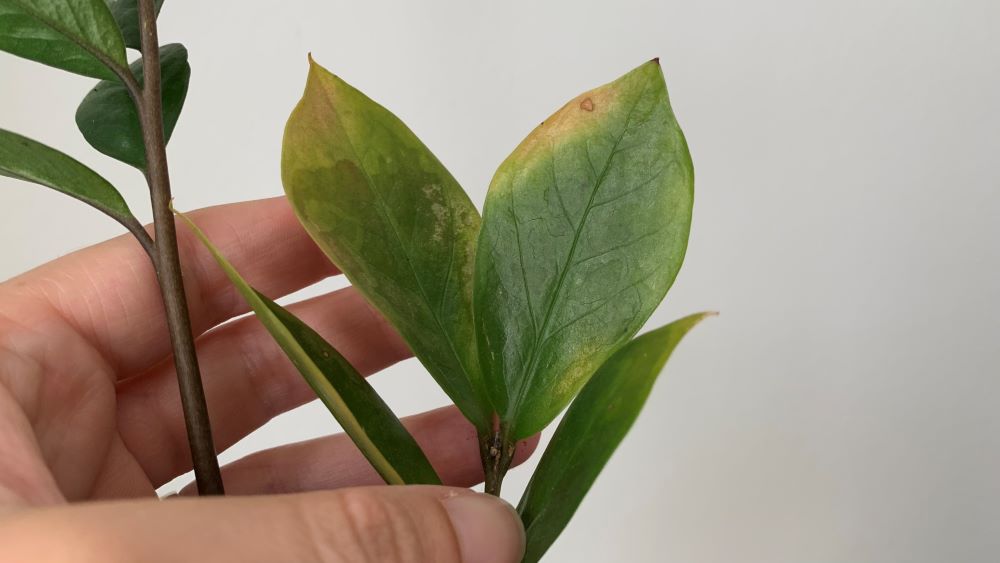
Some plants like succulents and cactus prefer a mix of soil that has even more drainage. Look out for specialist mixes that will have larger organic pieces to allow for better drainage.
For most indoor plants they will benefit from a small dose of fertilizer in spring and fall. I like to use an all-purpose indoor plant food for all of my indoor plants to make it easier. They all get fertilizer at the same time so I don’t need to remember to go back and do it again.
For ZZ plant and sansevieria, fertilize them once per year with the same food. I find that these plants need les fertilizer as they tend to have a slower growth rate than palms or vines.
3. Not enough light
Indoor plants that are not getting enough light can develop weak spots in their leaves. Most indoor plant benefit from at least 5-6 hours of bright filtered light. Indoor plants are usually tropical plants that are used to shade but not enough light can still slow their growth.
Other signs of plants not getting enough light include drooping and yellowing of the leaves. If your plant is getting enough water and fertilizer then light could be the problem.
Plants will often lean in the direction of the light if they need more. I find that even my pothos leaves will point towards the window to try to absorb as much sunlight as possible.
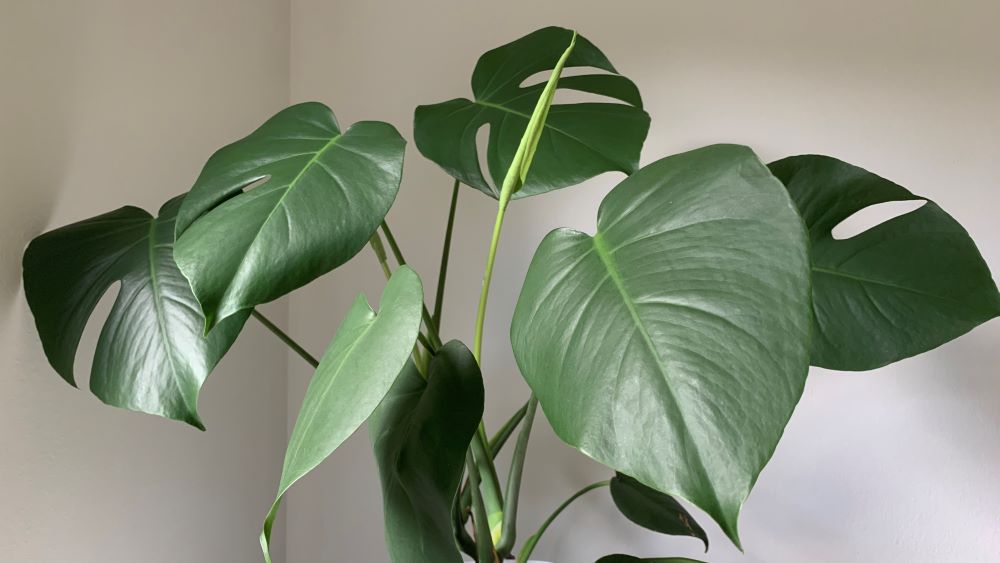
Move plants to a filtered light position. Placing them near a window that gets filtered morning light is a great option. I find that Monstera in particular needs lots of light. Without it the plant can lean, grow lop sided or the leaves will droop down.
If you don’t have a bright light position in your house grab an indoor grow light. These UV lights are low cost and they can give your indoor plants the light they need to thrive.
If you have a dark spot that you want to brighten up with a green plant reach for ZZ plants. They are very tolerant of a low light position.
4. Physical damage
Another major cause of holes developing in pothos leaves is physical damage. This is actually a common cause of holy indoor plant leaves. Kids, pets, and ourselves can all be to blame for tearing and making holes in potted plant leaves.
I find that any time I am moving or repotting my plants there is a risk that I will put holes in the leaves. I often sit the pot on top of the trailing vines of my pothos or will knock monstera leaves.
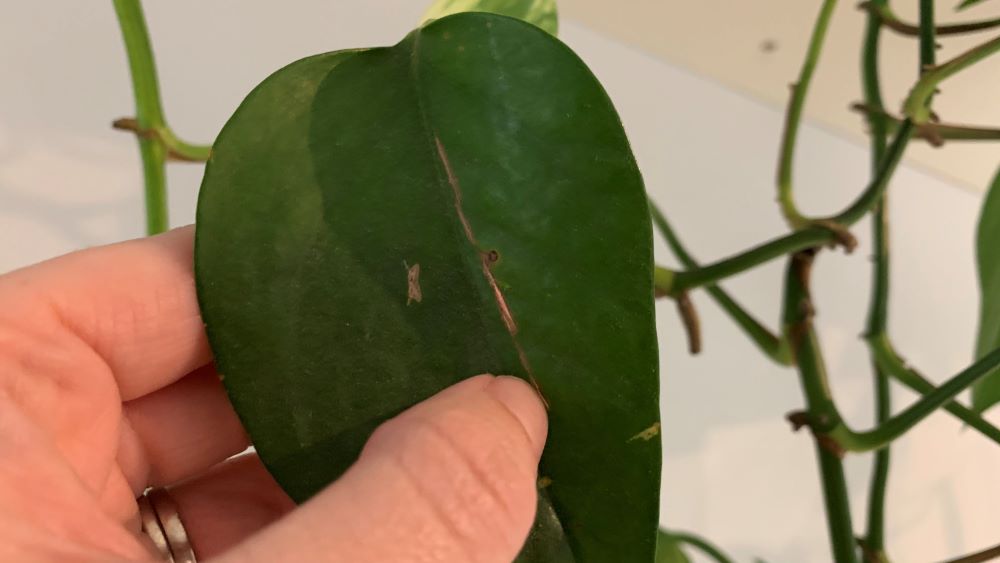
For monstera I will take the opportunity to remove excess leaves when repotting. If your pothos has plenty of leaves then snipping off any damaged ones will not harm the plant.
Pothos vines will grow back fast if you accidentally damage and put holes in leaves or stems. Just snip the stem off above the damage and it will grow back soon.
Insects that can cause holes on indoor plants
There are some insects that can get onto your indoor plants. They can find their way in from other plants that you bring home from the nursery or they may already be on the plant. Insects can even fly in through the window. If your plant is sitting near an open window even with a screen, insects can venture in and attach to your indoor plan.
Here are the top insects that can attack and make holes in your indoor plants.
5. Scale
Scale insects can find their way indoors. I had a blackbean plant indoors and within a few weeks it was covered in scale. It was likely that scale eggs were already on the plant when I bought it home from the nursery.
Scale are a tricky bug to get rid of once they form a hard shell over their body. They will stick tightly to the stem or leaf of your plant. They will eat the leaf matter and suck the sap from your plant leaving weak spots and holes.

To get rid of scale on indoor plants take the whole plant outside. I like to spray it with a quick jet of water to remove any bugs that are not holding on tight.
Spray the rest of the plant after it has dried with a dilute mix of neem oil. This is a natural extract from the neem tree that will treat these bugs fast. Bring the plant back inside and the neem oil will slowly work on the bugs.
If the scale have attached themselves tightly to the plant then you may need to apply the neem oil again to get rid of them all. Continue this 2-3 times to get rid of the scale for good.
6. Aphids
Aphids can find their way onto your indoor plants. They can be blown in on the wind or can be transferred from other plants to yours indoors. They can even be hiding on the indoor plants you buy from the nursery.
Aphids are often green or brown. They will sit along the leaf stems or veins sucking the sap from the plant. This can cause small brown holes as the aphids continue to suck the sap.

Aphids are easily treated with neem oil. Take the plant outdoors and spray it with a hose. You can skip this step if the plant is delicate and just spray it thoroughly with dilute neem oil. Allow the plant to dry then bring it back indoors.
Keep watering your plant regularly but avoid watering it directly on the leaves as will wash off the neem oil.
7. Spidermite
Spidermite are another tiny insect that can find their way onto your indoor plants. These tiny mites will usually travel onto your plants from others but can travel on the wind. Spidermite can be a range of colors but red-legged black spidermite are common.
Spidermite can breed quickly, sucking sap from the leaves and causing holes. These mites are easy to treat however and can usually be delt with in 1-2 treatments of neem oil. You can give your indoor plants a holiday outdoors as you deal with the spidermite.
Make sure you keep them in a protected position that is not getting any direct sun. Direct sunlight can quickly damage the leaves on your plant if it is used to be indoors.
Causes of holes in Indoor Plant Leaves | Summary
Holes in indoor plant leaves can occur through physical damage with rough handling, pest attack or if they are not getting enough water or nutrients. Keep your plant happy by fertilizing it once or twice per year with good quality indoor plant food, water them regularly and plant them in good quality soil.
If your plant is getting the light, water and food it needs then it will have stronger leaves which will be more resistant to pests and people.
Happy growing.
I am an accredited practicing dietitian, experienced gardener and a dedicated cook. I love writing and sharing my experience so you can learn from my successes and mistakes.
